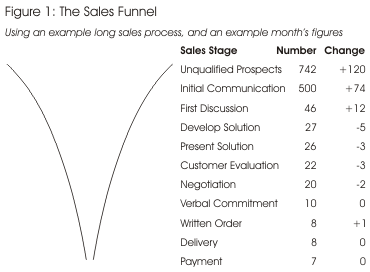With the idea of the Sales Funnel, we use the metaphor of a funnel (wide at the top, narrow at the bottom) to monitor the sales process.
At the top of the funnel you have "unqualified prospects" – the very many people who you think might need your product or service, but to whom you've never spoken. At the bottom of the funnel, many sales and delivery steps later, you have people who have received delivery of your product or service and have paid for it.
The metaphor of the funnel is used because people drop away at each stage of a long sales process: For example, many of your unqualified prospects may have existing suppliers with whom they're very satisfied. Others may have needs which other competitors are better-placed to satisfy. Still others may love your products, but not have the budget to buy them.

Why Use the Tool?
By using the sales funnel, and by quantifying the number of prospects at each stage of the process, you can predict the number of prospects who will, in time, become customers.
More than this, by looking at the way in which these numbers change over time, you can spot problems in the sales pipeline and take corrective action early.
For example, if you spot that very few mailings have taken place in a month, you might expect that in a few months time, sales might dry up. Next month, you should make sure that more mailers than normal are sent out.
Use of the Sales Funnel shows roadblocks and times of standstill, or if there are an insufficient number of leads at any stage. This knowledge allows you to determine where sales people should focus attention and efforts to keep sales at the desired level and to meet sales targets.
The funnel can also point out where improvements need to be made within the sales process. These may be as simple as implementing additional sales training or ensuring that sales representatives put sufficient focus on all steps of the sales process.
In the example shown in figure 1, a manager might be pleased by the amount of early stage prospecting in the month, but might worry that there's been a drop off in activity later in the sales process.
In the next month, he or she might work with sales people to increase the effort put into solution development and negotiation.
Tip:
If you're to use sales funnel reporting effectively, it's a huge benefit to have an effective and properly maintained sales contact management system, with a prospect status and progression workflow in-built. Without this, reporting can be hard work and very time-consuming.
If you're to use sales funnel reporting effectively, it's a huge benefit to have an effective and properly maintained sales contact management system, with a prospect status and progression workflow in-built. Without this, reporting can be hard work and very time-consuming.
How to use the tool:
The first stage in setting up sales funnel reporting is to understand your sales process fully (perhaps using a technique like flowcharting). While sales processes are often quite similar from company-to-company, there can be points of difference depending, for example, on the size of the order and the consequences to the client of making the wrong purchase decision.
Brainstorm the sales process with your sales and marketing people to make sure that it is correct and comprehensive.
From this, identify the key sequential steps in the sales process, and from these, create status codes. Try to keep these to a reasonably small number – otherwise reporting will be arduous, and it will be difficult to see meaningful patterns within the data.
Next, classify your prospects by the status codes you've identified. (Again, this will be much easier if you have a sales contact management system, and if people are disciplined about keeping this updated. Even better is if there's a sales workflow in place, so that as key tasks are performed, status codes are updated automatically.)
Finally, work out the number of prospects of each status, and calculate the change since the last month.
Tip:
As you build up a picture of your sales funnel from month to month for several months, you'll start to be able to see expected conversion rates from one stage of the process to the next.
As you build up a picture of your sales funnel from month to month for several months, you'll start to be able to see expected conversion rates from one stage of the process to the next.
By comparing these against the conversions other people are achieving, and comparing them against what you think you should be able to achieve, you can start to understand where you can improve your sales process. More than this, you can start making changes to the way you do things, and measuring the effects of these changes on conversion rates.
